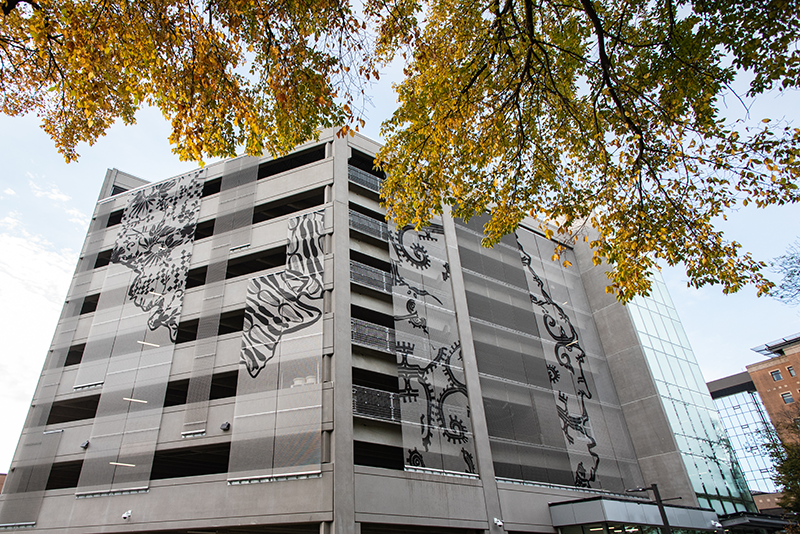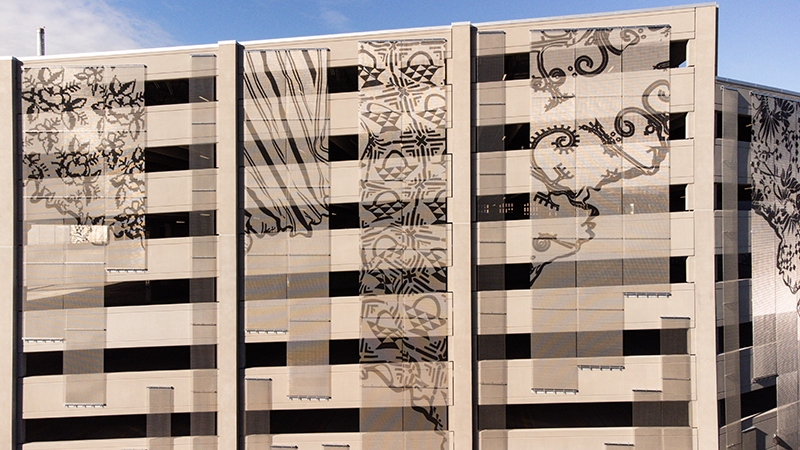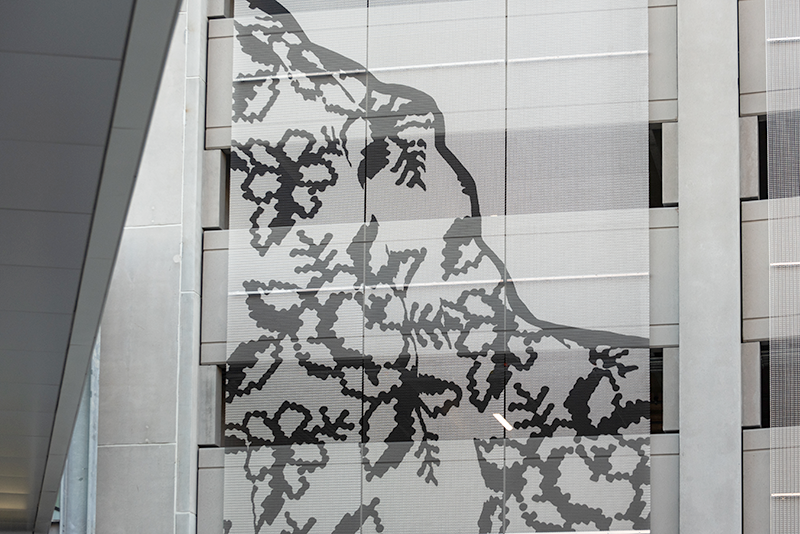 One of the lectures at Quilt Canada 2023 was presented by Andrea Tsang Jackson, who was recently commissioned to create a public art installation in Halifax. She titled the project In Conversation, in reference to the stories shared with her by several different craftspeople, whose work and legacies informed her designs. The following is a summary of Andrea’s talk.
One of the lectures at Quilt Canada 2023 was presented by Andrea Tsang Jackson, who was recently commissioned to create a public art installation in Halifax. She titled the project In Conversation, in reference to the stories shared with her by several different craftspeople, whose work and legacies informed her designs. The following is a summary of Andrea’s talk.
Photos by Deborah Wong.
An 8-storey parking garage may not sound like a welcome addition to the neighbourhood, but for quilt designer, educator, and textile artist Andrea Tsang Jackson, “a parking garage is a blank canvas for creative expression.”
The new garage on Summer Street in Kjipuktuk/Halifax, NS, is the first stage of a multi-year rejuvenation project for the QEII Health Services Centre, which serves more than 14,000 people per year. Not everyone was thrilled to hear about its construction, although now that it has been transformed by the Andrea’s artwork, at least one recent visitor to the city mistook it for a local museum.

In 2021, Andrea answered the call for proposals for a public art installation that celebrates the multiple cultural heritage of Nova Scotia. Aside from the architectural and structural challenges, the project became a learning journey for Andrea in terms of ensuring at every stage of the project that each of the cultures and artists represented was honoured with appropriate respect.
Andrea describes the project as an integration of art, architecture, and landscape. Her background in architecture—Andrea holds a Masters of Architecture from McGill University—was a great help in developing the artwork. While the architects of the project determined which materials would be utilized to apply the designs to the exterior of the structure, her experience in the field helped her understand the requirements of where the graphics should be placed and how they would ultimately be hung.
The project is comprised of six different patterned fabric designs, each inspired by a traditional craft practiced in Nova Scotia, and the stories of artists from various cultural backgrounds. For example, one of the designs—a Cherry Basket quilt block—was inspired by the basket-making and quilting practices of African Nova Scotians.
For another design, Andrea was drawn to the work of Ida Simon who makes traditional Mi’kmaw regalia, including a replica beaded jacket you can find at the Nova Scotia Museum. After considering a few options for utilizing a traditional beading motif, Andrea decided that the most respectful way to honour the artist’s work was to copy the design, with permission from the Mi’kmaq Grand Council.

She was very concerned about being exploitive during the process of creating all of the fabric patterns, and particularly of the regional Indigenous culture. Rather than re-interpret the beading work of Mi’kmaw artists, she decided it was best to represent their designs accurately.
Andrea used the principle “honour your subject; honour your viewers” whenever she faced the challenge of telling stories that were not her own.
For her own story, Andrea worked with embroidered linens. Her grandfather owned a textile trading company in Hong Kong, and she has an aunt and uncle who immigrated from Hong Kong to the US who run the same kind of business.
Similar to the other designs, Andrea explained that this one alludes to the idea that everyday objects, such as linen tablecloths, may not have much monetary value, but they have great value to us as families and communities.
Much handwork is traditionally done by women, although in the Gaelic tradition of felting cloth as practiced in Cape Breton, many community members participate, including men. During a Milling Frolic, freshly woven cloth is wetted, then pounded and rubbed by each participant before passing it on to the next person. A milling song helps to create a rhythm for the work. Andrea spoke with Mary MacLean of Halifax, who keeps the tradition alive by helping with Milling Frolics hosted as social events by communities in Nova Scotia. The design for this fabric represents both the woven cloth as it is held and passed from person to person, and the pattern of the Milling Frolic songs.
The Acadian tradition of rug hooking by crafters in Chéticamp, Cape Breton, was also honoured by Andrea. This design was inspired by the typical Chéticamp style used by Annie-Rose and Gérard Deveau in the 1970s, 80s, and 90s, when hooked rugs were created in Cape Breton and shipped all over the world.
The six resulting designs were printed on 14 panels made of architectural mesh (think “woven steel”), which allows air to flow through it; a vital consideration for a structure where automobiles are driven. Additionally, a secondary mesh allows for Virginia Creeper to grow up over time on empty panels that are not printed with Andrea’s fabric designs.
High-contrast black was chosen for the colour, which allows the artwork to be discernable from a distance. The garage is visible from the top of Citadel Hill, a prominent location downtown that is visited by hundreds of thousands of locals and tourists every year.

Here’s a brief overview of how the panels were created.
- Six different fabric patterns were designed.
- They were then printed on chiffon fabric.
- Binding was sewn on one edge of the fabric, and a wire was inserted, so that it could be formed into the shape of a section of Nova Scotia shoreline.
- The resulting piece was photographed and vectorized (made into an art file that could be manipulated in illustration software) and enlarged to create larger-than-life motifs.
- The images were then powder coated onto the stainless steel architectural mesh.
- The mesh was rolled into sections, which were hung from the building. Steel thread was used to join the sections together.
For a complete list of the artists, cultures, and stories that comprised Andrea’s intensive research for this project, visit Andrea’s website.


